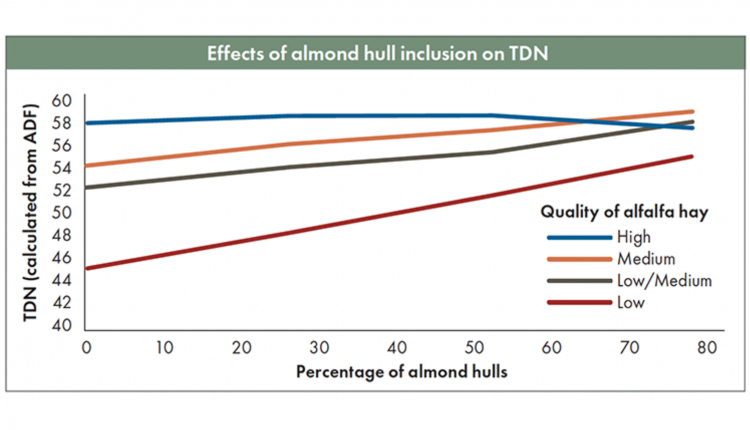Alfalfa-almond hull cubes show promise |
| By Hay and Forage Grower |
|
|
|
Hay & Forage Grower is featuring results of research projects funded through the Alfalfa Checkoff, officially named the U.S. Alfalfa Farmer Research Initiative, administered by National Alfalfa & Forage Alliance (NAFA). The checkoff program facilitates farmer-funded research. Pairing almond hulls with lower- to medium-quality alfalfa hay as a cubed or double-compressed animal feed may create new domestic and international markets – while improving hay quality, according to University of California (UC) researchers.  Dan Putnam Katie Swanson Funding: $48,358 “Almond hulls are very high in fermentable carbohydrates, and alfalfa is an excellent source of protein and digestible fiber. So, the question is whether they would work together in some positive fashion,” Putnam said. “A major impetus for doing this research is to discover value-added products. How can we add to the value of particularly medium- and lower-quality alfalfa hay? Is there a way to improve the quality of those hays and put them in a package that could be used for long-distance markets, including exports or domestic markets?” he asked. California is the largest almond producer in the world and the only place in North America commercially producing almonds. The almond industry is also looking for ways to market its byproducts, Swanson said. She has fed almond hulls as a concentrate replacement in previous dairy feeding trials. “But those carbohydrates are so high that I think you actually lose some of the benefits of alfalfa if you are taking alfalfa out and putting more almond hulls in.” The researchers maintained the amount of alfalfa in the diet “so we still have that digestible fiber and higher crude protein,” she said. “In our study, we developed samples of four different qualities of alfalfa: low, low-to-medium, medium, and high. Total digestible nutrients (TDN) ranged from 45% to 58%,” Swanson said. “Then we added in different amounts of almond hulls (0%, 25%, 50% and 75%), plus pure almond hulls, ending up with 17 different samples of alfalfa-almond hull mixes.” Samples were analyzed for forage quality and in vitro digestibility, utilizing a 72-hour gas production method to calculate metabolizable energy, as well as Daisy dry matter digestibility and neutral detergent fiber (NDF) digestibility at 12, 24, 30, and 48 hours. Analysis showed benefits to the mixes for lower- to medium-quality alfalfa hay. “Some of the in vitro work showed there was not as much benefit if you have fairly high-quality hay as a beginning point,” said Putnam. “But in lower-quality, high-fiber hays, there appears to be an advantage.” The sheep feeding trials used low- to medium-quality cubed hay with NDF valued at about 37%. Alfalfa cubes, including 0%, 10%, 20%, or 40% almond hulls, were fed to sheep over an eight-week period, with each animal experiencing each diet. Fecal harnesses collected samples that were analyzed for nutrient composition to quantify digestibility. “Cubes with 10% almond hulls had the highest dry matter, organic matter, and crude protein digestibility,” Swanson said. “Crude protein (CP) was about the same as it was for pure alfalfa cubes.” But CP, as well as acid detergent fiber (ADF) and NDF digestibility, dropped in diets with higher levels (20% and 40%) of almond hulls. “I was surprised by the reduction in fiber digestibility in these samples, since in the previous dairy cow study using high amounts of almond hulls, NDF digestibility improved when the diet utilized up to 20% almond hulls,” she said. However, the amount of lignin (the indigestible part of fiber) is higher in almond hulls than in alfalfa. That may have influenced the drop in digestibility when more than 10% almond hulls were added in the sheep study, Swanson surmised. They will continue with a dairy feeding trial using the alfalfa-almond hull cubes, funded by the Almond Board of California, Swanson said. Putnam added, “The role and synergy of alfalfa-almond hull interactions may be different in a total dairy ration than in a 100% forage diet that we observed in the sheep trial.” “These data suggest that there are potential benefits for in vitro and in vivo digestibility when low amounts (for example, 10%) of almond hulls are mixed with low- to medium-quality alfalfa, but not higher qualities of alfalfa hay,” Putnam said. “Mixing alfalfa hay with almond hulls lowers NDF and ADF concentrations, thereby improving RFV (relative feed value) and TDN values, which may be of interest to marketers. Further research on impacts of these products in diets for lactating dairy cows would be helpful.”  Project Results 1. Alfalfa hay combined with ground almond hulls lowered the NDF and ADF content, reduced crude protein, but improved the RFV and TDN of the product. 2. Cubed mixes of modest amounts of almond hulls added to low- to medium-quality alfalfa, fed to sheep, could improve overall dry matter and crude protein digestibility and soluble carbohydrates with only slight declines in fiber digestibility. This article appeared in the February 2022 issue of Hay & Forage Grower on pages 22 & 23. Not a subscriber? Click to get the print magazine. |
